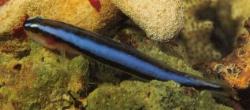 Family: Gobiidae
Family: Gobiidae
Confusion
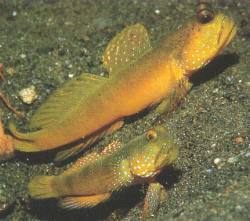
Many people confuse gobies and blennies (Blenniidae) and, indeed, common names have been interchanged between the two families with little regard for scientific fact! In nearly all cases, the goby is easily distinguished as it has fused pelvic fins forming a sucker-like disc which can be used as an aid to cling to vertical surfaces. In this way, gobies are quite capable of living in areas of high turbulence. Whilst it is true that some gobies appear to lack this suction disc, closer inspection reveals that the pelvic fins are indeed joined, but closer to the body. Gobies can further be distinguished from blennies owing to the fact that nearly all species have two separate dorsal fins.
Firefish (Nemateleotris sp.) are often erroneously regarded as gobies. Although this was (inexplicably) the case up until the early 1980's, firefish have since found a permanent home in the family of wormfishes (Microdesmidae) and should no longer be regarded as gobies.
Swim Bladder
In common with blennies, gobies do not have a swim bladder and as a consequence, spend most of their time in a stationary resting position. Swimming excursions into open water are necessarily brief and carried out with a jerky action. They mostly pursue small morsels of food drifting in the current before quickly returning. This is typical goby feeding behaviour; taking every advantage of any passing food opportunity but not actually chasing anything beyond the limits of safety.
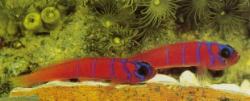 Sharing
Sharing
Marine gobies, in particular, are fairly gregarious and often occupy the same burrow with a mate or another individual of the same or similar species. If territories are established, they are usually quite small, and depending on the species, may be defended with vigour or in a seemingly half-hearted manner.
Sex
Sexual differences are very obvious in some species; for example, the male Catalina Goby (Lythrypnus dalli) has a greatly extended first dorsal ray which is absent in the female. Therefore, a sexed pair is easily identified and can be introduced into a suitable aquarium. The sex of many other species are not quite so obvious and to all intents and purposes, males and females are externally identical.
Successful spawnings and subsequent raising to adulthood in a captive environment have taken place with several species of goby. The most notable being the Caribbean Neon Goby (Gobiosoma oceanops), which is bred commercially in the USA.
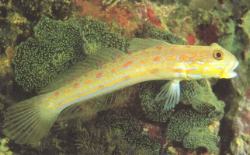 Gobies are substrate spawners and it is usually the male which guards the eggs until they hatch. The larvae - for they are still too underdeveloped to be termed 'fry' - then drift off into the plankton layers to develop, before migrating back down to the sea floor as juveniles.
Gobies are substrate spawners and it is usually the male which guards the eggs until they hatch. The larvae - for they are still too underdeveloped to be termed 'fry' - then drift off into the plankton layers to develop, before migrating back down to the sea floor as juveniles.
On a personal note, I have had spawning successes with Catalina Gobies, Neon Gobies and Orange-Spotted Gobies (Valenciennea puellaris). All took place in a 16 gallon single-species tank with undergravel filtration and a protein skimmer. The Catalina and Neon Gobies could be encouraged to spawn in small cave or pipe after being conditioned with plenty of live food (brineshrimp). The eggs are tiny and no more than specks of dust! Unfortunately, the larvae were extremely difficult to locate, let alone feed!
But the most fascinating breeding behaviour was exhibited by the Orange-Spotted Gobies. The female would lay her eggs in a half flowerpot and, after fertilising, the male would then proceed to bury the flowerpot beneath the sand, with the female still inside! The male then stood guard over the mound. I observed this behaviour several times and the female would always emerge after about seven days in the best of health. Without doubt, this must be one of the most fascinating, not to say effective, methods of fish reproduction I have ever come across.
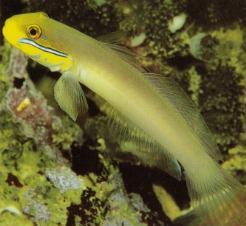 Feeding
Feeding
Almost without exception, gobies are very easy fish to feed in the aquarium environment. They like to take food whilst it is drifting in the current and particularly enjoy live foods such as brineshrimp, as well as frozen mysis and small rivershrimp. Other foods should be chosen to suit the size of the particular species. A good variety might include: frozen brineshrimp, mysis, chopped cockle, shellmeat and squid. Many species will often accept marine flake quite readily.
Two feedings every day is quite adequate; one in the morning and again in the evening. A variety of foods will avoid dietary deficiencies which could otherwise lead to disease.
The Invertebrate Tank
Most gobies are very suitable for the marine invertebrate aquarium and will do little, or no damage. However, there are one or two exceptions that the hobbyist may want to be aware of. Firstly, the Lemon Goby (Gobiodon citrinus) finds a natural home within Acropora sp. and other related branching hard corals. They can rub their bodies against a favoured spot and destroy the polyps on that particular branch or even cause the demise of the whole coral. If a pair are kept, spawning often occurs within the same favoured branches and once again, the coral may be damaged. There is little the marinist can do in these circumstances but it is as well to be aware of the situation if valuable branching corals are kept.
Larger gobies often spend most of their time scooping up mouthfuls of coral sand, sieving it for small particles of food, the passing it out through the gills. Frustratingly, this sand may be expelled over sessile invertebrates, causing them some distress. Probably the most common culprit for this behaviour is the Blue-Cheek Goby (Valenciennea strigata) and once again the hobbyist should be aware of this possible disruption before attempting to introduce this particular species of fish.
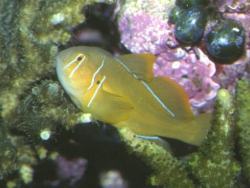 Gobies do not have it all their own way, however. Many of the very small species can easily fall prey to predatory anemones and crabs, as well as Mantis and Pistol shrimps. Neon, Catalina and in particular, may suffer an early demise through predation from this source.
Gobies do not have it all their own way, however. Many of the very small species can easily fall prey to predatory anemones and crabs, as well as Mantis and Pistol shrimps. Neon, Catalina and in particular, may suffer an early demise through predation from this source.
Sharing and Compatibility
Most gobies are very tolerant of others in their family and will often share an aquarium quite happily with a non-similar species. However, care must be exercised if the same, or similar, species are introduced as there might be a degree of harassment (usually chasing) from the most dominant individual. Pairs, as we have seen, can form strong bonds and may never stray further than a few inches from each other.
In common with many other species of fish, the larger the aquarium, the fewer and less intense any disputes over territory will be.
The marinist will often visit his/her local retailer to find various gobies occupying the same aquarium quite peacefully. In cases such as these, species purchased from such an aquarium can be expected to live peacefully when transferred to a more permanent home.
As far as general compatibility is concerned, gobies are make excellent peaceful community introductions. Care must be taken to make sure that larger fish do not regard them as a potential meal or a threat against territory. Other than that, gobies can be relied upon to be compatible with most other unrelated species.
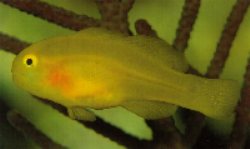 Helpful Gobies
Helpful Gobies
We have already seen how some of the larger sand-sifting gobies can spray grain of coral sand over sessile invertebrates and cause a minor nuisance; however, their is an upside to this type of behaviour, particularly with undergravel filter owners. Both Orange-Spotted and Blue-Cheek Gobies will constantly disturb the substrate and keep it free from compaction, as well as consuming any unwanted food particles trapped therein (although the Blue-Cheek Goby has an annoying habit of spitting the sand grains over corals!). Now and again, the hobbyist will have to smooth out the substrate if the "craters on the moon" effect is to be avoided, but this is a small price to pay for such a valuable service.
Healthcare
Fortunately, the family Gobiidae suffer very little from common aquarium diseases. As long as water quality is good and the aquarium is neither overfed or overstocked, gobies will generally remain healthy. Whitespot and Oodinium can become a problem if the fish are stressed and the aquarist should make regular inspections after a new introduction.
Tank Conditions
A 90-120cm (3-4ft) aquarium must be regarded as the minimum for community purposes, although very small species may tend to get 'lost' in a very large aquarium and will almost invariably suffer in the competition for food.
pH: 8.0-8.3
Ammonia & Nitrites: zero
Nitrate: Not exceeding 25ppm, preferably less than 10ppm
S.G: 1.020-1.024
Temperature: 25-26°C (77-79°F)
Efficient protein skimming and activated carbon should be regarded as standard. An ultra-violet steriliser is very useful to prevent disease in an invertebrate aquarium.
15-20% water change every two weeks.
Good water circulation is essential.
Lighting: Moderate to bright lighting is tolerated well, although some species do prefer a dimly lit area in which to retreat from time to time.
Species and Introduction
Almost without exception, it is best to introduce gobies towards the beginning of any stocking plan. They need to establish themselves gradually without the possible attentions of more competitive fish if undue stress is to be avoided.
Some of the more commonly available and desirable fish include:-
Neon Goby (Gobiosoma oceanops) 25mm (1")
Catalina Goby (Lythrypnus dalli) 25mm (1")
Orange-Spotted goby (Valenciennea puellaris) 10cm (4")
Blue-Cheek Goby (Valenciennea strigata) 18cm (7")
Yellow Goby (Gobiodon okinawae) 30mm (1.2")
Sulphur Goby (Cryptocentrus cinctus) 10cm (4")
Lemon Goby (Gobiodon citrinus) 30mm (1.2")
There are many other interesting species of goby that can be seen in aquarium stores from time to time and it is worth keeping an eye out for these.
© Nick Dakin. May not be reproduced in part, or whole, without permission.

